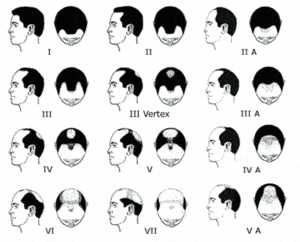In order to determine the best course of treatment for hair loss, it is important to understand the progression. The Norwood-Hamilton scale is the generally accepted standard to measure the extent of hair loss in men.
The most common type of male hair loss is called androgenetic alopecia, often referred to as “male pattern baldness” or “male pattern hair loss.” Male pattern hair loss is responsible for hair loss in about 90% of men. It can begin as early as the teens or twenties and is caused by a combination of genetic predisposition and male sex hormones.
There are several different patterns for male hair loss. The most common are a receding hairline beginning at the temples, thinning at the crown of the head (also called the vertex), and general thinning of the hair across large areas of the scalp without much direct change to the hairline. Men can experience one of these patterns of hair loss or a combination of all three.
The Norwood-Hamilton Scale outlines the different stages of male pattern hair loss. Vertex stages show hair loss at the crown of the head, while the “A” patterns demonstrate a more dramatic pattern of hair loss. Although this type of hair loss impacts less than 10% of men, it often appears more severe because hair loss is concentrated in the front of the head.

Stage I: shows an adolescent hairline, generally located on the upper brow crease. There is no hair loss at the hairline or crown of the head.
Stage II: demonstrates the progression to an adult hairline, which sits slightly above the upper brow crease. Hair loss at this stage is very mild and usually concentrated at the frontal hairline.
Stage III: is the earliest stage of hair loss considered cosmetically significant enough to be called “baldness” according to this scale. At this stage, most men show a deep symmetrical recession at the temples, which are either bare or only sparsely covered with hair. The vertex figure here shows the additional thinning of the hair at the crown of the head.
Stage IV: includes a deepening recession at the front of the head in the temple areas. Hair loss at the crown is evident and often a bridge of moderately dense hair will separate hair loss at the front of the scalp from that at the vertex or the crown of the head. The sides of the head are typically well-covered with hair.
Stage V: marks the beginning of severe hair loss. While there remains a small separation between the loss of hair at the hairline and the loss of hair at the crown, the band of hair between the two is much thinner and narrower. Hair loss at both the crown and the temporal regions are larger and more distinct.
Stage VI: The bridge of hair that once separated the front of the head from the crown is now almost fully lost, only a few sparse strands may persist. The remaining hair now forms a horseshoe shape around the baldness concentrated in the center of the scalp. Hair loss on the sides of the head will also extend further at this stage.
Stage VII: The most advanced stage of hair loss, only a wreath of thin hair remains on the sides and back of the scalp.
